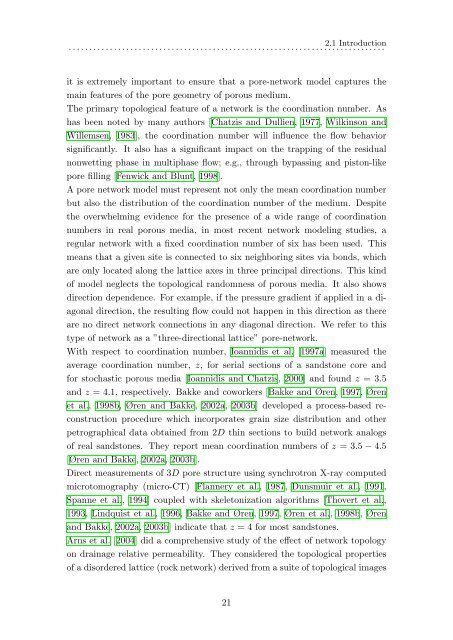download pdf version of PhD book - Universiteit Utrecht
download pdf version of PhD book - Universiteit Utrecht
download pdf version of PhD book - Universiteit Utrecht
You also want an ePaper? Increase the reach of your titles
YUMPU automatically turns print PDFs into web optimized ePapers that Google loves.
2.1 Introduction<br />
. . . . . . . . . . . . . . . . . . . . . . . . . . . . . . . . . . . . . . . . . . . . . . . . . . . . . . . . . . . . . . . . . . . . . . . . . . . . .<br />
it is extremely important to ensure that a pore-network model captures the<br />
main features <strong>of</strong> the pore geometry <strong>of</strong> porous medium.<br />
The primary topological feature <strong>of</strong> a network is the coordination number. As<br />
has been noted by many authors [Chatzis and Dullien, 1977, Wilkinson and<br />
Willemsen, 1983], the coordination number will influence the flow behavior<br />
significantly. It also has a significant impact on the trapping <strong>of</strong> the residual<br />
nonwetting phase in multiphase flow; e.g., through bypassing and piston-like<br />
pore filling [Fenwick and Blunt, 1998].<br />
A pore network model must represent not only the mean coordination number<br />
but also the distribution <strong>of</strong> the coordination number <strong>of</strong> the medium. Despite<br />
the overwhelming evidence for the presence <strong>of</strong> a wide range <strong>of</strong> coordination<br />
numbers in real porous media, in most recent network modeling studies, a<br />
regular network with a fixed coordination number <strong>of</strong> six has been used. This<br />
means that a given site is connected to six neighboring sites via bonds, which<br />
are only located along the lattice axes in three principal directions. This kind<br />
<strong>of</strong> model neglects the topological randomness <strong>of</strong> porous media. It also shows<br />
direction dependence. For example, if the pressure gradient if applied in a diagonal<br />
direction, the resulting flow could not happen in this direction as there<br />
are no direct network connections in any diagonal direction. We refer to this<br />
type <strong>of</strong> network as a ”three-directional lattice” pore-network.<br />
With respect to coordination number, Ioannidis et al. [1997a] measured the<br />
average coordination number, z, for serial sections <strong>of</strong> a sandstone core and<br />
for stochastic porous media [Ioannidis and Chatzis, 2000] and found z = 3.5<br />
and z = 4.1, respectively. Bakke and coworkers [Bakke and Øren, 1997, Øren<br />
et al., 1998b, Øren and Bakke, 2002a, 2003b] developed a process-based reconstruction<br />
procedure which incorporates grain size distribution and other<br />
petrographical data obtained from 2D thin sections to build network analogs<br />
<strong>of</strong> real sandstones. They report mean coordination numbers <strong>of</strong> z = 3.5 − 4.5<br />
[Øren and Bakke, 2002a, 2003b].<br />
Direct measurements <strong>of</strong> 3D pore structure using synchrotron X-ray computed<br />
microtomography (micro-CT) [Flannery et al., 1987, Dunsmuir et al., 1991,<br />
Spanne et al., 1994] coupled with skeletonization algorithms [Thovert et al.,<br />
1993, Lindquist et al., 1996, Bakke and Øren, 1997, Øren et al., 1998b, Øren<br />
and Bakke, 2002a, 2003b] indicate that z = 4 for most sandstones.<br />
Arns et al. [2004] did a comprehensive study <strong>of</strong> the effect <strong>of</strong> network topology<br />
on drainage relative permeability. They considered the topological properties<br />
<strong>of</strong> a disordered lattice (rock network) derived from a suite <strong>of</strong> topological images<br />
21

















